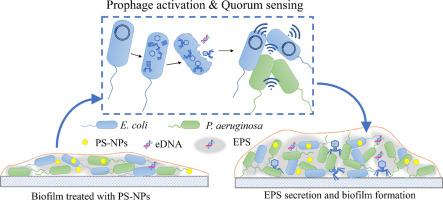纳米塑料诱导噬菌体激活和群体感应增强生物膜的机械和化学弹性
IF 12.4
1区 环境科学与生态学
Q1 ENGINEERING, ENVIRONMENTAL
引用次数: 0
摘要
尽管纳米塑料(NPs)在自然和工程水系统中的普遍存在以及它们与微生物风险的关联,但在生物膜形成的背景下,细菌-噬菌体相互作用在很大程度上被忽视了。本文研究了带正电荷(PS-NH 2)和负电荷(PS-COOH)的聚苯乙烯纳米塑料(PS-NPs)对由大肠杆菌(λ+)和铜绿假单胞菌组成的双物种生物膜的影响。PS-NPs在环境相关浓度(例如100-1000 ng/L)下促进生物膜的形成和稳定性,其中PS-NH₂的影响更大。PS-NPs的细胞内化增加了2.18-2.25倍的活性氧(ROS)水平,引发了暴露于PS-NPs后大肠杆菌(λ+)裂解的噬菌体λ活化。转录组学分析表明,PS-NPs,特别是PS-NH₂,激活了SOS响应(2.35-2.63倍),λ噬菌体复制(2.68-3.97倍)和种间群体感应(2.24-5.13倍),蛋白质组学分析证实了这一点。因此,PS-NPs刺激保护性细胞外聚合物(EPS)分泌,eDNA含量增加至325.8 ~ 433.8 μg/cm2。EPS产量的增加有助于改善生物膜的机械性能(原子力显微镜测量值为1.46-1.57倍),并提高对氯消毒的抵抗力。管道生物膜的宏基因组分析表明,PS-NPs促进了细菌与噬菌体的相互作用,增强了细菌的抗病毒防御系统,从而刺激了多物种生物膜的形成,增强了环境适应能力。总的来说,我们的研究结果为纳米塑料和噬菌体动力学之间的相互作用提供了新的见解,强调了与水性纳米塑料相关的微生物风险增加。本文章由计算机程序翻译,如有差异,请以英文原文为准。

Nanoplastics Induce Prophage Activation and Quorum Sensing to Enhance Biofilm Mechanical and Chemical Resilience
Despite the prevalence of nanoplastics (NPs) in natural and engineered water systems and their association with microbial risks, bacterium-phage interactions have been largely overlooked in the context of biofilm formation. Here, we investigated the effects of positively (PS-NH₂) and negatively (PS-COOH) charged polystyrene nanoplastics (PS-NPs) on dual-species biofilms composed of Escherichia coli (λ+) and Pseudomonas aeruginosa. PS-NPs promoted biofilm formation and stability at environmentally relevant concentrations (e.g., 100-1000 ng/L), with PS-NH₂ exhibiting higher influence. The cellular internalization of PS-NPs increased the reactive oxygen species (ROS) levels by 2.18-2.25 folds, triggered prophage λ activation followed by lysis of E. coli (λ+) after exposure to PS-NPs. Transcriptomic analyses revealed that PS-NPs, especially PS-NH₂, activated the SOS response (2.35-2.63-fold), λ phage replication (2.68-3.97-fold), and interspecies quorum sensing (2.24-5.13-fold), which was verified by the proteomic analyses. Therefore, PS-NPs stimulated protective extracellular polymeric substances (EPS) secretion with eDNA content increased to 325.8-433.8 μg/cm2. Enhanced EPS production contributed to improved biofilm mechanical properties (1.46-1.57-fold as measured by atomic force microscopy) and increased resistance to chlorine disinfection. Metagenomic analysis of pipeline biofilm demonstrated that PS-NPs promoted bacterium-phage interactions and enhanced bacterial antiviral defense systems, which stimulated multi-species biofilm formation and enhanced environmental resilience. Overall, our findings provide novel insights into the interplay between nanoplastics and bacterium-phage dynamics, highlighting increased microbial risks associated with waterborne nanoplastics.
求助全文
通过发布文献求助,成功后即可免费获取论文全文。
去求助
来源期刊

Water Research
环境科学-工程:环境
CiteScore
20.80
自引率
9.40%
发文量
1307
审稿时长
38 days
期刊介绍:
Water Research, along with its open access companion journal Water Research X, serves as a platform for publishing original research papers covering various aspects of the science and technology related to the anthropogenic water cycle, water quality, and its management worldwide. The audience targeted by the journal comprises biologists, chemical engineers, chemists, civil engineers, environmental engineers, limnologists, and microbiologists. The scope of the journal include:
•Treatment processes for water and wastewaters (municipal, agricultural, industrial, and on-site treatment), including resource recovery and residuals management;
•Urban hydrology including sewer systems, stormwater management, and green infrastructure;
•Drinking water treatment and distribution;
•Potable and non-potable water reuse;
•Sanitation, public health, and risk assessment;
•Anaerobic digestion, solid and hazardous waste management, including source characterization and the effects and control of leachates and gaseous emissions;
•Contaminants (chemical, microbial, anthropogenic particles such as nanoparticles or microplastics) and related water quality sensing, monitoring, fate, and assessment;
•Anthropogenic impacts on inland, tidal, coastal and urban waters, focusing on surface and ground waters, and point and non-point sources of pollution;
•Environmental restoration, linked to surface water, groundwater and groundwater remediation;
•Analysis of the interfaces between sediments and water, and between water and atmosphere, focusing specifically on anthropogenic impacts;
•Mathematical modelling, systems analysis, machine learning, and beneficial use of big data related to the anthropogenic water cycle;
•Socio-economic, policy, and regulations studies.
 求助内容:
求助内容: 应助结果提醒方式:
应助结果提醒方式:


